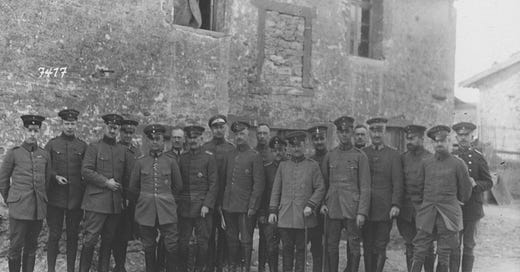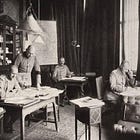Operations
In 1914, the First Section [Abteilung I] of the staff of an infantry division rated two officers. The senior of these, who was often described simply as ‘the general staff officer’, was the only fully-fledged officer of the General Staff serving in a division.
The junior officer of the First Section bore the hard-to-translate title of Ordonnanz-Offizier. Like his counterparts on the staffs of brigades and regiments, he often served as an ‘empowered messenger’, delivering and, if required, explaining, the tactical instructions of the commanding general. In addition to this, he had qualified as an interpreter, with expertise, I presume, in either French or Russian.
By 1918, the First Section had acquired a second General Staff officer and a second Ordonnanz-Offizier. It had also split into two subsections, Ia and Ib.
Within Ia, the ‘first general staff officer’, handled matters related to operations, tactics, organization, artillery, and communications. His principal assistant, known as the ‘third Ordonnanz-Offizier’ collected reports from subordinate commanders, supervised the distribution of written orders, and kept the division war diary. (Note the partnership between the senior of the two general staff officers of the division and the lowest-ranking of the Ordonnanz-Offiziere on the division staff.)
The officer in charge of Ib, known as the ‘second general staff officer’, dealt with both logistics and intelligence. In particular, he dealt with the distribution of quarters, the supply of food and ammunition, traffic control, transportation, relations with local civilians, the handling of prisoners of war, the capture of spies, and aerial reconnaissance. The other officer in Ib, the ‘second Ordonnanz-Offizier’ supervised supply columns and depots, the work of military policemen, the writing of reports intended for public consumption, and relations with the press.
During the interwar period, Ib split into two sub-sections, thus creating the three operational sub-sections (operations, operational logistics, and intelligence) described, in 1938, by Captain Albert C. Wedemeyer of the US Army. Each of these sub-sections, called Ia, Ib, and Ic, rated a general staff officer, often identified by the name of the section he led, and an Ordonnanz-Offizier, known, as O1,O2, or O3. (The designations of general staff officers and Ordonnanz-Offiziere aligned neatly. Thus, O1 assisted the Ia, O2 for the Ib, and so forth.)
Administration
A German infantry division of 1914 enjoyed the services of two adjutants, the 1. Adjudant and the 2. Adjudant. Both of these officers hanged their hats in the Adjudantur, which was also known as the Second Section [Abteilung II] of the division staff.
Over the course of the First World War, the Adjudantur traded its second adjutant for an Ordonnanz-Offizier. Notwithstanding the order in which their positions had been created, the assistant to the adjutant bore the designation of 1. Ordonnanz-Officer while that of the Ia was known as the 2. Ordonnanz-Officer.
The replacement of the second adjutant in each division by an Ordonnanz-Offizier seems to reflect the need to provide the many new divisions formed in the First World War with an officer wise in the ways of military administration. (While any commissioned officer could be employed as an Ordonnanz-Offizier, a division adjutant had earned his spurs as the adjutant of a smaller organization. In many cases, moreover, he had studied at one of the two staff colleges [Kriegsakademien] of the German Empire.)
In much the same way, the practice observed by Captain Wedemeyer in 1938, of employing a military official [Wehrmachtbeamter] as the principal assistant to the division adjutant, may have something to do with the great increase in the number of divisions that took place in the German Army in the late 1930s.
Military Law
In the years between 1914 and 1938, the Third Section [Abteilung III] of the division, which handled legal matters, remained the domain of a senior military official. In 1914, this uniformed civil servant bore the title of ‘field justice official’ [Feldjustizbeamter]. By 1918, however, he had acquired the (somewhat more impressive) designation of ‘councilor for courts martial’ [Kriegsgerichtsrat].
Supply
In 1914, the Fourth Section [Abteilung IV] of a division staff broke down into three subsections. The largest of these, IVa, dealt with the supply of food, fodder, ammunition, and other consumables. IVb provided a perch for the division surgeon. IVc sheltered the two chaplains.
During the First World War, the padres donated the alphanumeric designation of their subsection to the senior veterinarian [Stabsveterinär] appointed to take care of large (and growing) number of horses serving with each division. (In the course of the war, the assignment of heavy artillery batteries, trench mortar companies, and additional machine gun companies to infantry divisions added greatly to the equine population of such formations.)
In the immediate aftermath of their displacement by the horse doctors, the chaplains dwelt in sub-section IVd. Eventually, however, they exchanged this humble abode for a section of their own, one that bore the number V.
Sources:
Hermann Cron Die Organisation des deutschen Heeres im Weltkriege (Berlin: E.S. Mittler, 1923) page 41
Albert C. Wedemeyer German General Staff School (unpublished report, 3 August 1938) page 31
For Further Reading:










